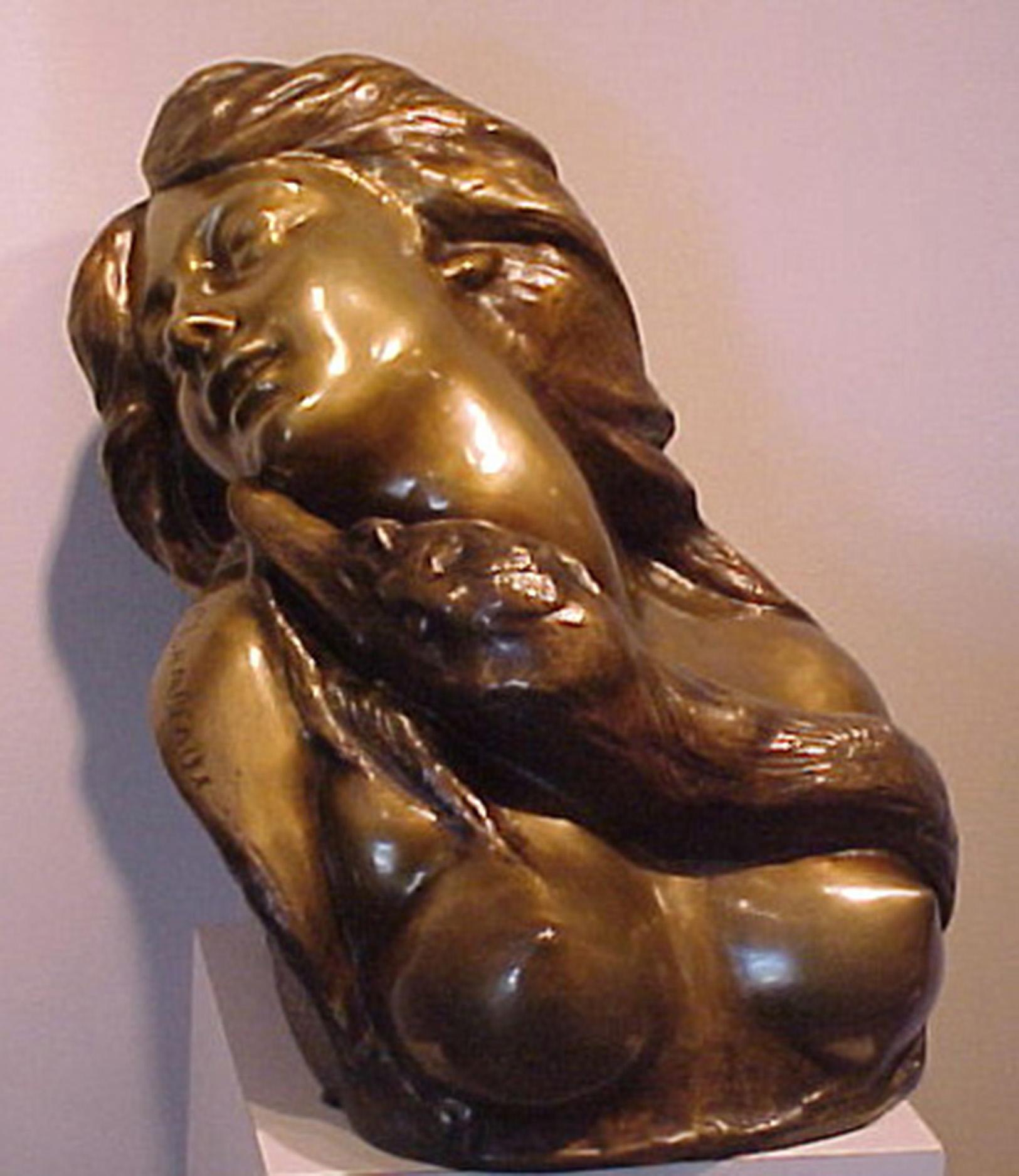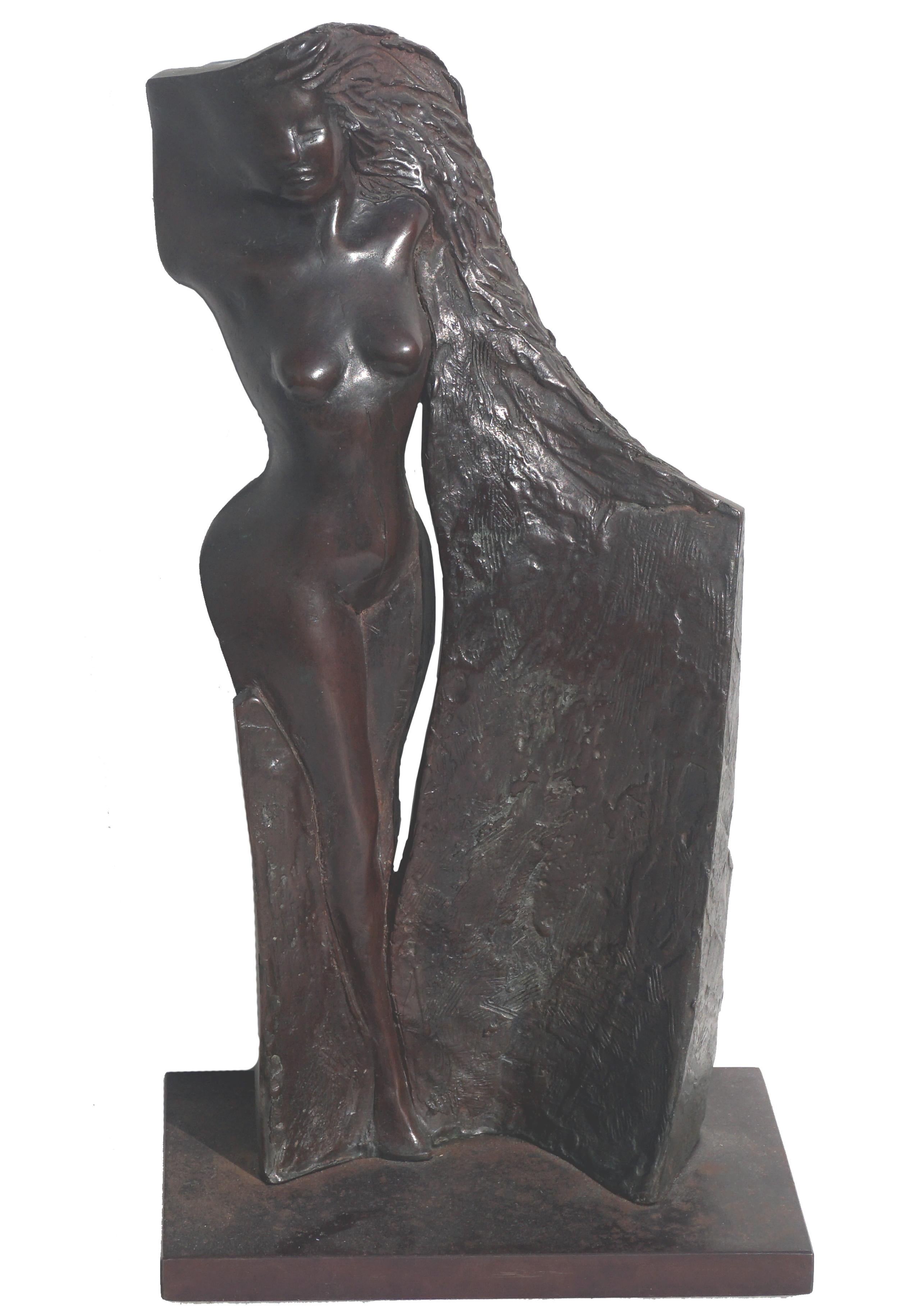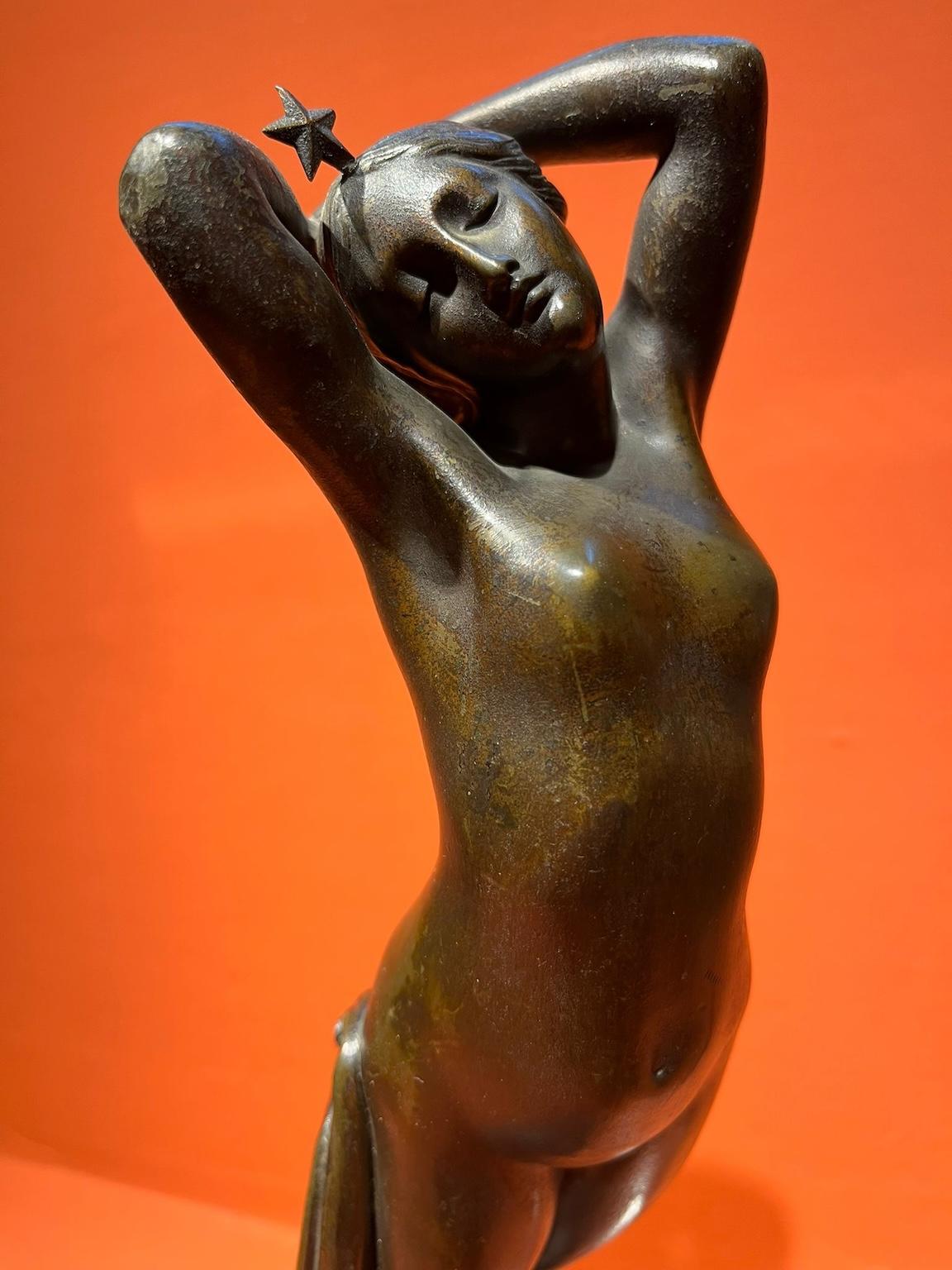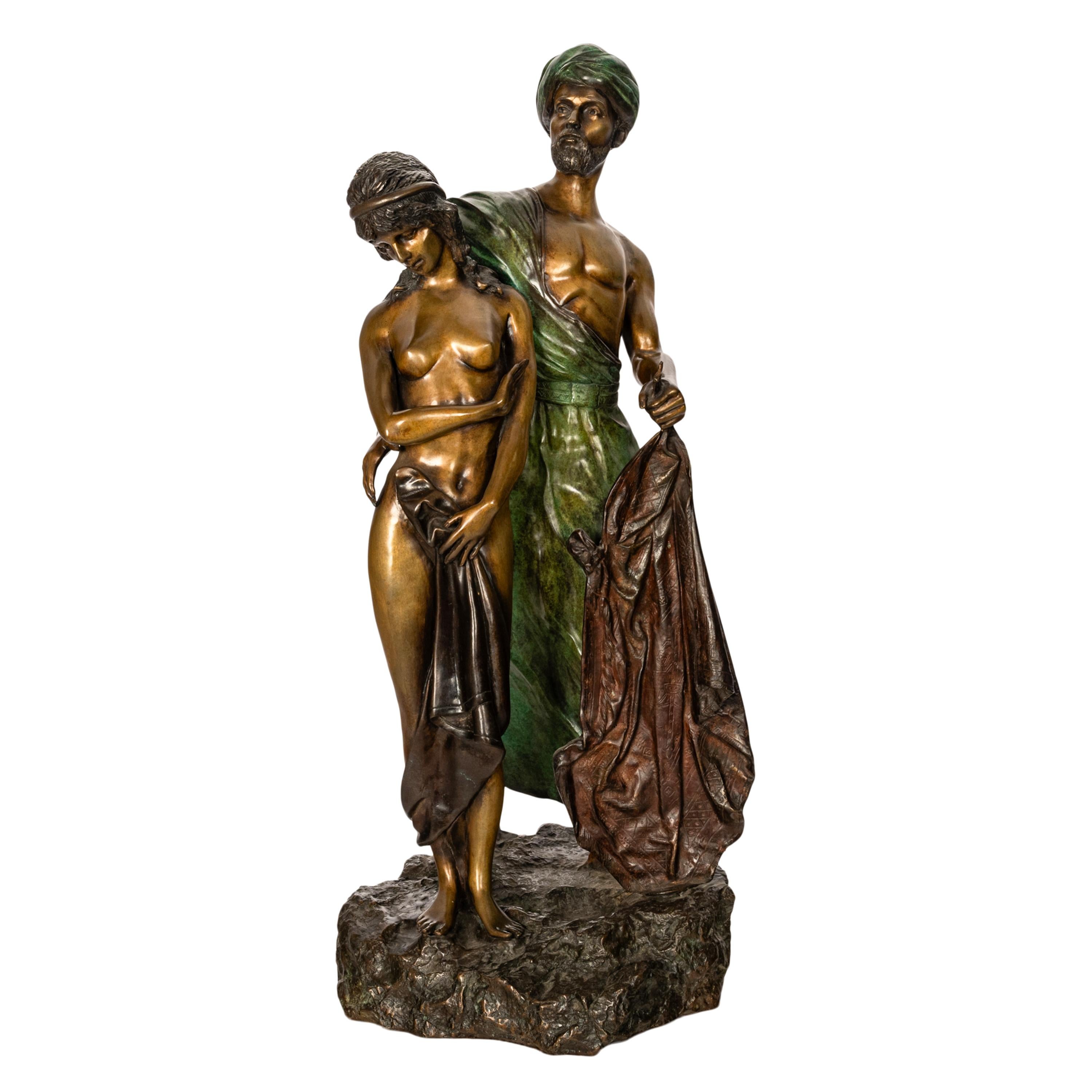Jean-Léon GérômeApple Dancercirca 1890-1900
circa 1890-1900
About the Item
- Creator:Jean-Léon Gérôme (1824 - 1904, French)
- Creation Year:circa 1890-1900
- Dimensions:Height: 25.6 in (65 cm)Width: 8.67 in (22 cm)Depth: 11.82 in (30 cm)
- Medium:
- Movement & Style:
- Period:
- Condition:
- Gallery Location:PARIS, FR
- Reference Number:
Jean-Léon Gérôme
One of the most prominent French Academic painters of the 19th century, Jean-Léon Gérôme is today credited with fashioning an entirely new artistic ideology. One of the originators of the Orientalist style, Gérôme was also a stalwart defender of Academic painting, which was waning under the rise of realism and Impressionism. Inspired by the year he spent in Rome with Paul Delaroche in 1834, he developed an insatiable appetite for traveling, and throughout his career, he traveled widely in Turkey, Egypt, and North Africa. His years exploring the Near East inspired his greatest Orientalist works, his Moorish and Turkish bath scenes.
A sculptor as well as a painter, Gérôme’s female figures have the same classical precision of Ingres but are executed with a more pronounced sensuality and realism. Enjoying great popularity and success during his lifetime, he was actively courted and patronized by private collectors and nobility. Today, the majority of Gérôme's works are held in major museums, with very few remaining in private hands.
Find authentic Jean-Léon Gérôme paintings on 1stDibs.
(Biography provided by M.S. Rau)

- ShippingRetrieving quote...Ships From: PARIS, France
- Return PolicyA return for this item may be initiated within 3 days of delivery.
- Nature unveiling in front of ScienceBy Louis Ernest BarriasLocated in PARIS, FRNature unveiling in front of Science by Louis-Ernest Barrias (1841-1905) Bronze sculpture with multiple patina. Signed "E. Barrias" on the side of the base cast by "Susse Frères" (foundry mark and stamp) The model of this statue was commissioned in 1889 to decorate the new medical school in Bordeaux. When he had finished the first version in white marble for the school, Barrias designed a second marble and onyx statue in 1899 for the ceremonial staircase of the Conservatoire des Arts et Métiers in Paris. France circa 1900 height 58 cm Biography : Louis-Ernest Barrias (1841-1905) was a French sculptor . He came from a family of artists. His father was a porcelain painter and his older brother, Felix-Joseph Barrias, a recognized painter. Louis-Ernest Barrias entered the School of Fine Arts in Paris in 1858, he abandoned painting to move towards sculpture under the direction of François Jouffroy. In 1864, he won the Prix de Rome, on the theme of "The Foundation of Marseille", and was engaged on the site of the Paris Opera house. He later produced many sculpted works, most of them in marble. In 1881, Louis-Ernest Barrias was awarded a medal of honor of the fine arts and named knight of the Legion of Honor in 1878, then promoted officer in 1881 and commander in 1900. The artist replaced Auguste Dumont at the Institute in 1884, then succeeded Jules Cavelier as a professor at the School of Fine Arts, where, among his most notable students, there were Victor Ségoffin, Charles Despiau and Paul Landowski.Category
Early 20th Century Art Nouveau Figurative Sculptures
MaterialsBronze
- The SongBy Félix CharpentierLocated in PARIS, FR"The Song" by Félix Charpentier (1858-1924) A very fine bronze sculpture with nuanced dark brown patina Signed "Fx. Charpentier" Cast by "E. Colin & Cie Paris" France around 1900 he...Category
Early 1900s Art Nouveau Figurative Sculptures
MaterialsBronze
- Snake CharmerBy Albert-Ernest Carrier-BelleuseLocated in PARIS, FRBronze sculpture with a nuanced dark brown patina signed on the base "A. Carrier" inscribed on a front plaque "Charmeuse de Serpents par Carrier-Belleuse" France circa 1860 height 80,5 cm Biography : Albert-Ernest Carrier de Belleuse known as Carrier-Belleuse (1824-1887) was one of the most prolific artists of the century and had the greatest successes under the Second Empire, enjoying the personal support of Napoleon III. His work was greatly influenced by the style of the Italian Renaissance and that of the 18th century, which he helped to bring up to date. In 1837, the young Carrier-Belleuse apprenticed in the workshop of the engraver Bauchery. He was admitted soon after to the goldsmith Jacques Henri Fauconnier. Through François Arago, he met the sculptor David d'Angers who facilitated his admission to the School of Fine Arts. Carrier-Belleuse entered it in 1840. Noted for his skill by the great bronze companies in Paris such as Barbedienne and Denière, he soon received numerous orders for models for candelabras, pendulums, fittings for fireplaces, etc. In 1848, probably at the initiative of François Arago, who became head of state, he received his first public order for a small statue of "Mademoiselle Rachel singing La Marseillaise". In 1851, he appeared for the first time at the Salon of French Artists, where he presented two bronze medallions. From 1851 to 1855, Carrier-Belleuse stayed in England, in Stoke-on-Trent where he served as director of the modeling and drawing school of the Minton house, a large porcelain manufacturer. Back in France, Carrier-Belleuse moved to Paris in a large workshop located 15 rue de la Tour d´Auvergne. From 1857, he made regular sendings to the Salon and became famous thanks to the success of large marbles, such as the "Bacchante" exhibited at the Salon in 1863, and acquired by Napoleon III, "Angelica" (1866) or even "Hebe asleep" (1869). At the Salon of 1867, his group entitled "Messiah" earned him the medal of honor of sculpture. It was acquired by the State to adorn the Chapel of the Virgin in the Saint-Vincent-de-Paul church. Carrier-Belleuse acquired a great reputation in parallel for his terracotta busts which, in many respects, recall those of 18th century artists. He made portraits of a large number of celebrities of his time. He produced, among others, the busts of Napoleon III, Renan, Thiers, Grévy, Arago, Marguerite Bellanger, Théophile Gautier, Honoré Daumier, Delacroix, Hortense Schneider, Réjane… He also modelled numerous busts of mythological inspiration and historical and artistic portraits like Marie Stuart, Shakespeare or even Mozart. Carrier-Belleuse used and trained in his workshop in the rue de la Tour d´Auvergne many young talented artists such as Alexandre Falguière, Jules Desbois...Category
1860s French School Figurative Sculptures
MaterialsBronze
- The ComedyLocated in PARIS, FRPierre-Marie POISSON (1876-1953) The Comedy Bronze sculpture with black patina signed on the base "P. Poisson" Cast by Valsuani (with the foundry stamp) Raised on a stone base Fra...Category
1930s French School Figurative Sculptures
MaterialsBronze
- Woman taking off her shirtLocated in PARIS, FRWoman taking off her shirt by James PRADIER (1790-1852) Bronze with a nuanced brown patina cast by SOYER and INGE France circa 1850 height 28,5 cm Biography : Jean-Jacques Pradier...Category
1850s French School Nude Sculptures
MaterialsBronze
- The KissBy Aimé-Jules DalouLocated in PARIS, FRThe Kiss also named "Nymph and Faun" by Jules DALOU (1838-1902) A bronze group with a black patina Signé "Dalou" A very fine cast by "A.A. Hébrard" (with the foundry stamp) The ca...Category
Early 1900s French School Figurative Sculptures
MaterialsBronze
- Leda and the SwanLocated in West Hollywood, CAPresenting a magnificent early Art Nouveau bronze by Belgian artist Jef Lambeaux(1852-1908.) “Leda and the Swan”, is an original Art Nouveau Bronze,...Category
1880s Art Nouveau Figurative Sculptures
MaterialsBronze
- Modernist Bronze Sculpture of a Nude WomanLocated in Soquel, CAAbstracted sculpture of a nude woman by Francis Xavier "Frank" Bracken (American, 20th Century). Signed, dated and numbered "Francis X. Bracken 1981 2/7...Category
1980s Art Nouveau Nude Sculptures
MaterialsSteel, Bronze
- 19th century French mythological figurative female bronze statuetteBy Joseph PolletLocated in Florence, ITLate 19th-century bronze figure derived from a work by Jean Michel-Angel Pollet-a Palermo artist of French parents who was a pupil of Bertel Thorvaldsen and Peter Tenerani - titled ...Category
Late 19th Century Art Nouveau Nude Sculptures
MaterialsBronze
- Franz Bergmann Orientalist Arab Slave Nude Group Cold Painted Bronze Signed 1910By Franz BergmannLocated in Portland, ORA very large 24" (61cm) Franz Xavier Bergmann (1861-1936) cold painted bronze group statue, signed, Austria, circa 1910. The bronze in the Orientalist manner & depicts a young slave ...Category
1910s Art Nouveau Figurative Sculptures
MaterialsBronze
- Nude Girl and Swan BronzeLocated in Miami, FLThis stylized figural study captures a young girl restraining a struggling swan trying to take flight purportedly by Marius Jean Antonin Mercié, bearing the incised signature “Mercié” on the base.. The work is quite heavy weighing in about 65 lbs and boasts an opulent dark patina. Unlike his signature work Gloria Victis, that has numerous versions, reproductions and casts, Girl and Swan may be of just a few casts or may be unique. With Barbedienne foundry mark on the tree stump behind the left foot. Mercie used Barbedienne for many of his works. Purchased from Toulouse Antiques...Category
1910s Art Nouveau Nude Sculptures
MaterialsBronze
- Jean Garnier Bronze of a Sea Nymph or SirenBy Jean GarnierLocated in San Francisco, CAJean Garnier (1853-1910) Art Nouveau Bronze Sculpture circa 1890s A Fine bronze sculpture by listed French artist Jean Garnier. A young nude woman with long flowing hair and a tamb...Category
Late 19th Century Art Nouveau Nude Sculptures
MaterialsBronze




